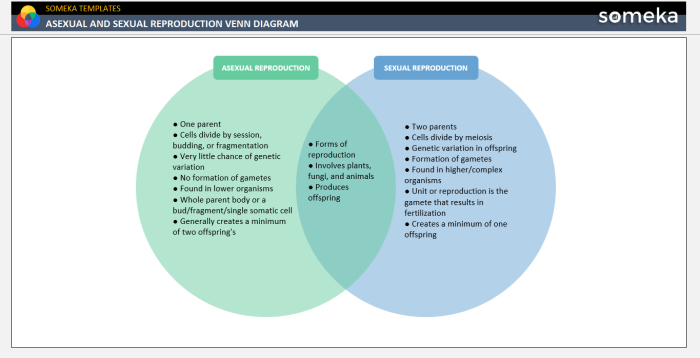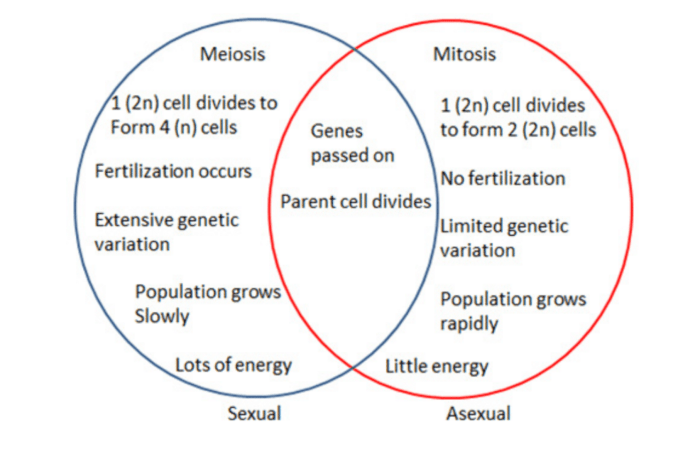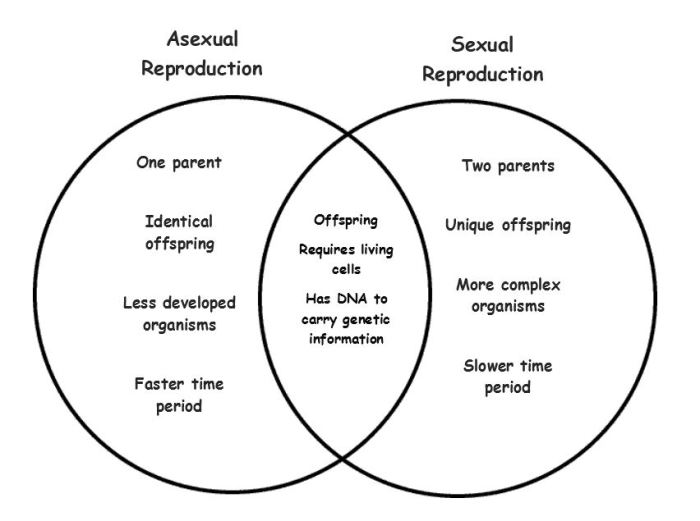Sexual and asexual reproduction venn diagram provide a valuable tool for understanding the similarities and differences between these two fundamental reproductive strategies. This article explores the key characteristics, advantages, disadvantages, and evolutionary implications of sexual and asexual reproduction, using a Venn diagram to illustrate their distinct features.
Sexual and Asexual Reproduction: Sexual And Asexual Reproduction Venn Diagram

Sexual and asexual reproduction are two fundamental processes that ensure the continuation of life on Earth. While both methods lead to the creation of new individuals, they differ significantly in their mechanisms and genetic implications.
Definition of Sexual and Asexual Reproduction
Sexual reproductioninvolves the fusion of gametes, specialized reproductive cells, from two different individuals. This process results in genetic recombination, creating offspring with a unique combination of traits inherited from both parents.
Asexual reproduction, on the other hand, involves the production of offspring from a single parent. This process does not involve the fusion of gametes and results in offspring that are genetically identical to the parent.
The fundamental difference between sexual and asexual reproduction lies in the genetic diversity of the offspring. Sexual reproduction promotes genetic diversity, while asexual reproduction maintains genetic uniformity.
Venn Diagram Representation
A Venn diagram can be used to visually represent the similarities and differences between sexual and asexual reproduction:
| Sexual Reproduction | Asexual Reproduction |
|---|---|
| Involves fusion of gametes | Does not involve fusion of gametes |
| Results in genetic recombination | Results in genetically identical offspring |
| Promotes genetic diversity | Maintains genetic uniformity |
| Requires two parents | Requires only one parent |
Advantages and Disadvantages
Sexual Reproduction
Advantages:
- Promotes genetic diversity
- Increases adaptability to changing environments
- Reduces the risk of genetic disorders
Disadvantages:
- Requires two individuals
- Can be time-consuming and energy-intensive
- May lead to competition for mates
Asexual Reproduction
Advantages:
- Efficient and rapid
- Does not require finding a mate
- Ensures the survival of species in stable environments
Disadvantages:
- Does not promote genetic diversity
- Increases vulnerability to changing environments
- May lead to genetic disorders
Examples of Sexual and Asexual Reproduction
| Sexual Reproduction | Asexual Reproduction |
|---|---|
| Humans | Bacteria |
| Plants | Fungi |
| Animals | Hydra |
| Birds | Starfish |
Impact on Genetic Diversity, Sexual and asexual reproduction venn diagram
Sexual reproduction plays a crucial role in maintaining genetic diversity within populations. The fusion of gametes from different individuals shuffles and recombines genetic material, creating offspring with a unique combination of traits. This diversity allows populations to adapt to changing environmental conditions and reduces the risk of genetic disorders.
Asexual reproduction, on the other hand, does not promote genetic diversity. Offspring produced through asexual reproduction are genetically identical to the parent, which can limit their ability to adapt to environmental changes and increase their susceptibility to genetic disorders.
Questions Often Asked
What is the key difference between sexual and asexual reproduction?
Sexual reproduction involves the fusion of gametes from two parents, resulting in offspring with a unique genetic combination. Asexual reproduction, on the other hand, occurs without the involvement of gametes, producing offspring genetically identical to the parent.
What are the advantages of sexual reproduction?
Sexual reproduction promotes genetic diversity, which enhances a population’s ability to adapt to changing environmental conditions. It also allows for the purging of harmful mutations from the gene pool.
What are the disadvantages of asexual reproduction?
Asexual reproduction can lead to genetic uniformity, making populations more vulnerable to environmental changes. Additionally, asexual populations are more susceptible to the accumulation of harmful mutations.



